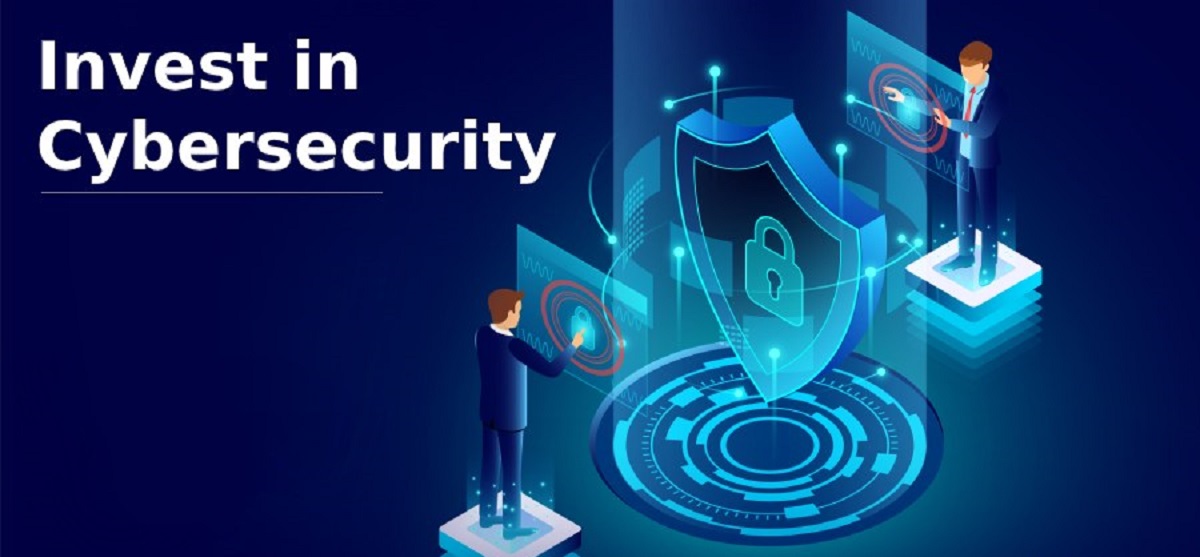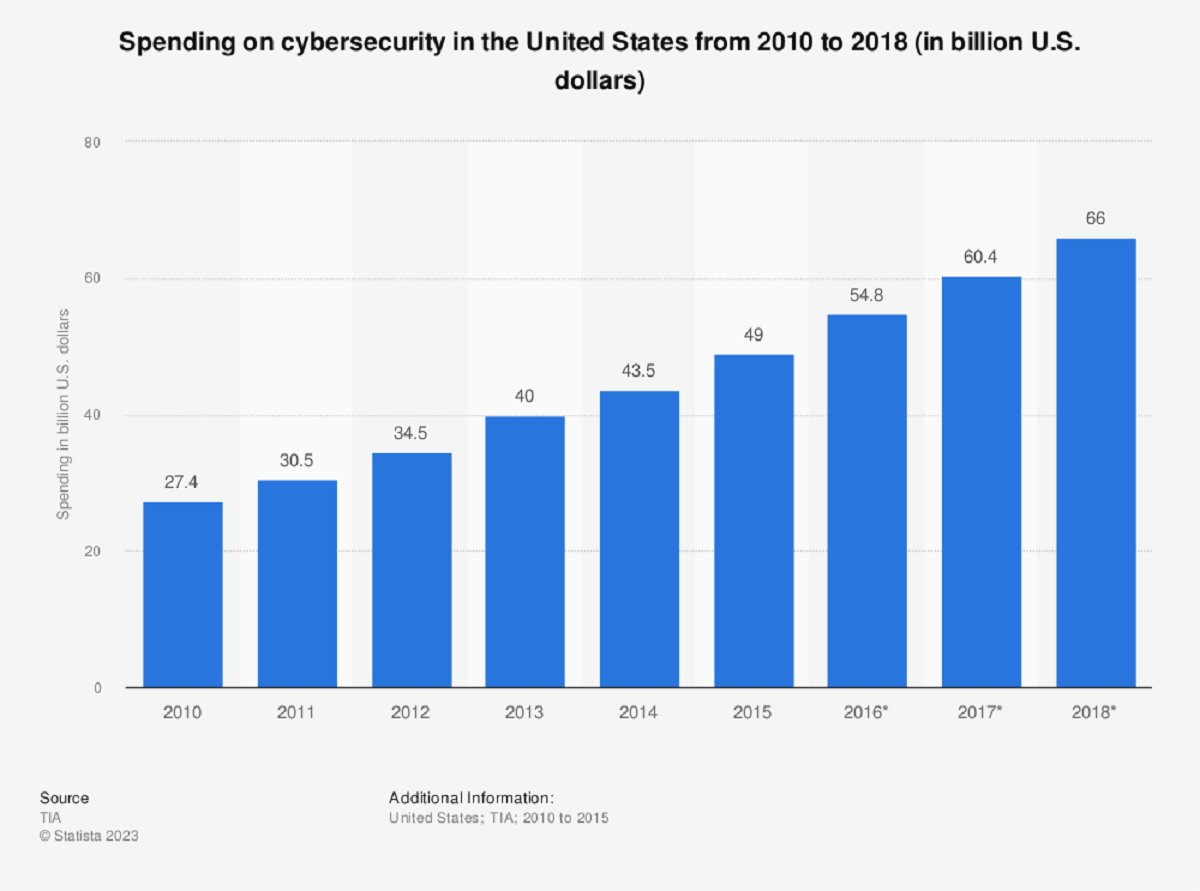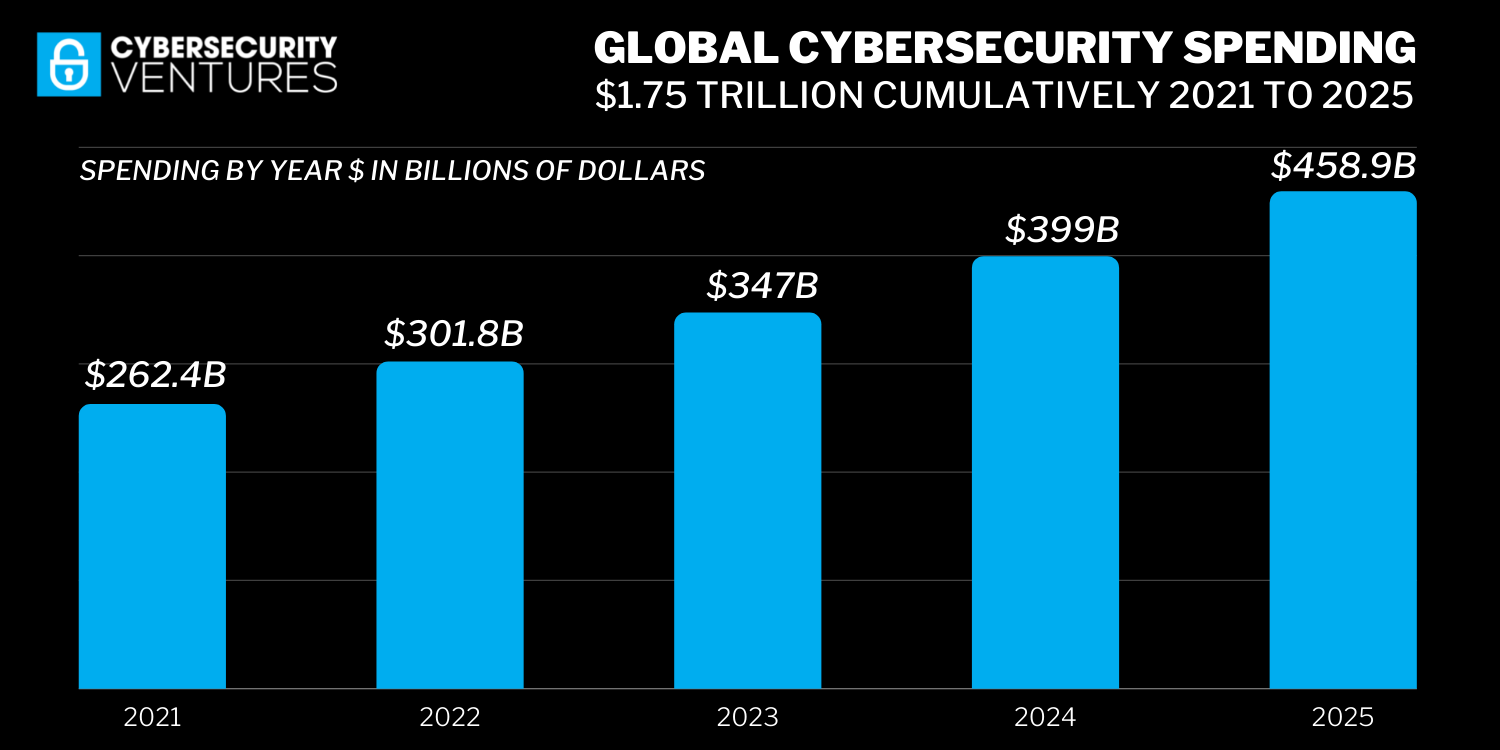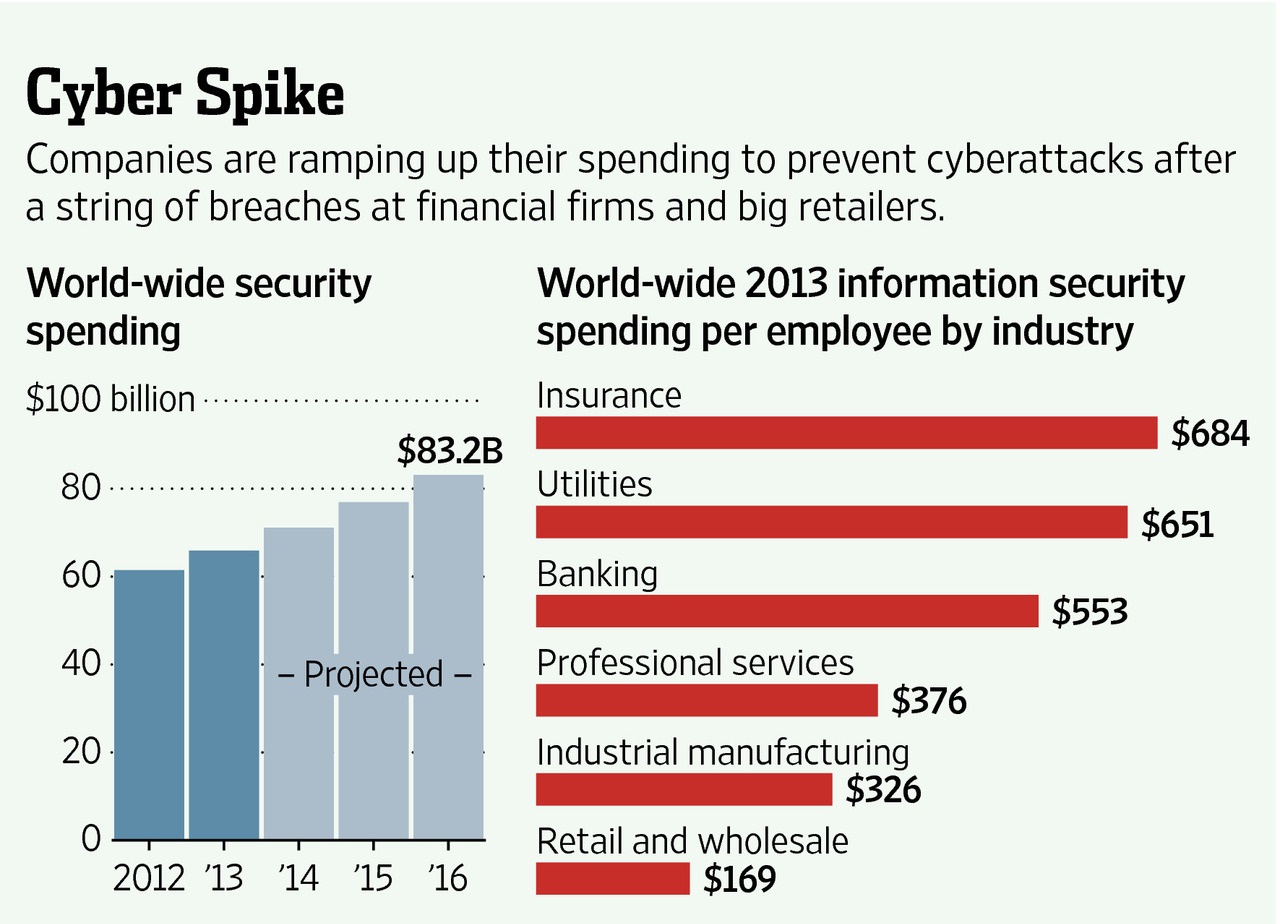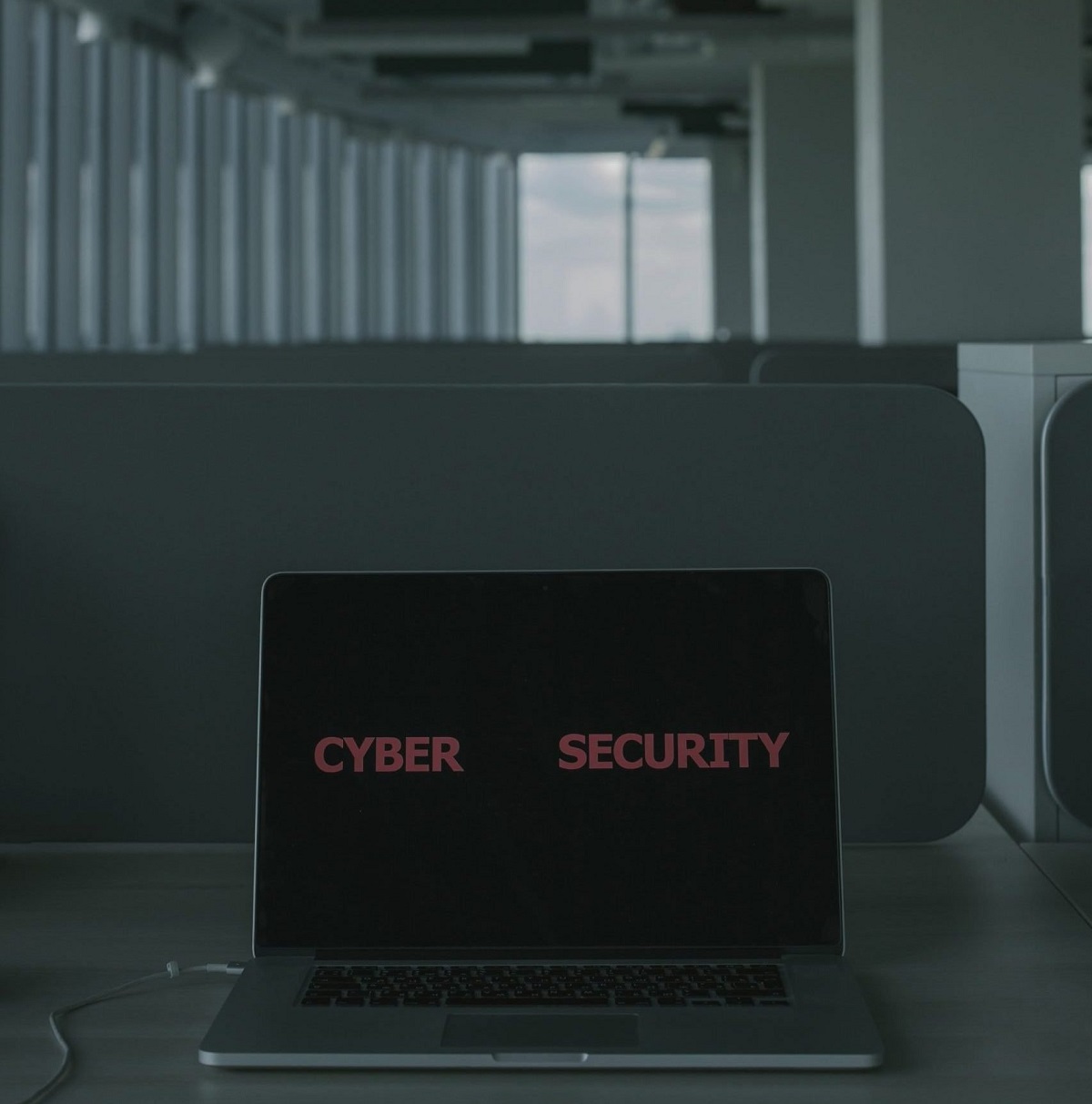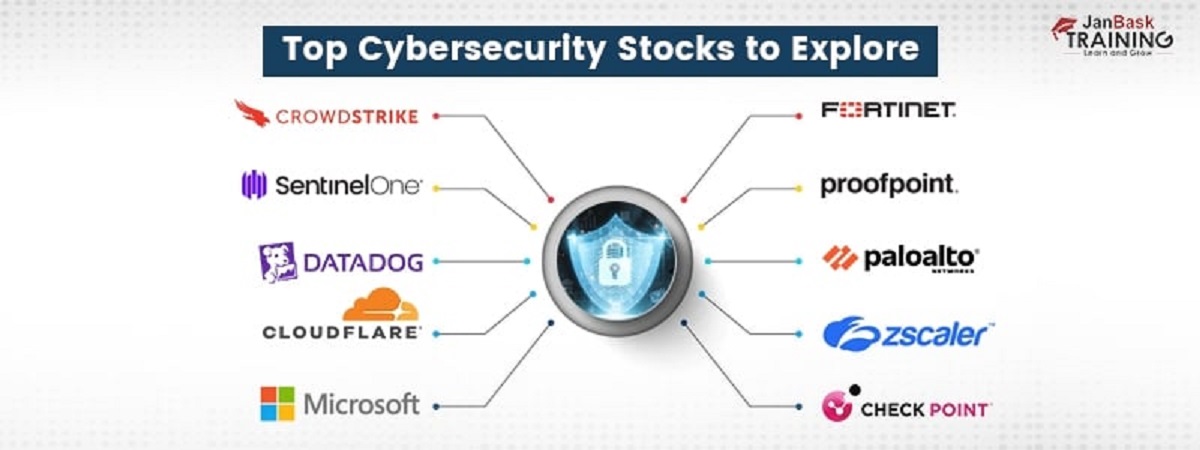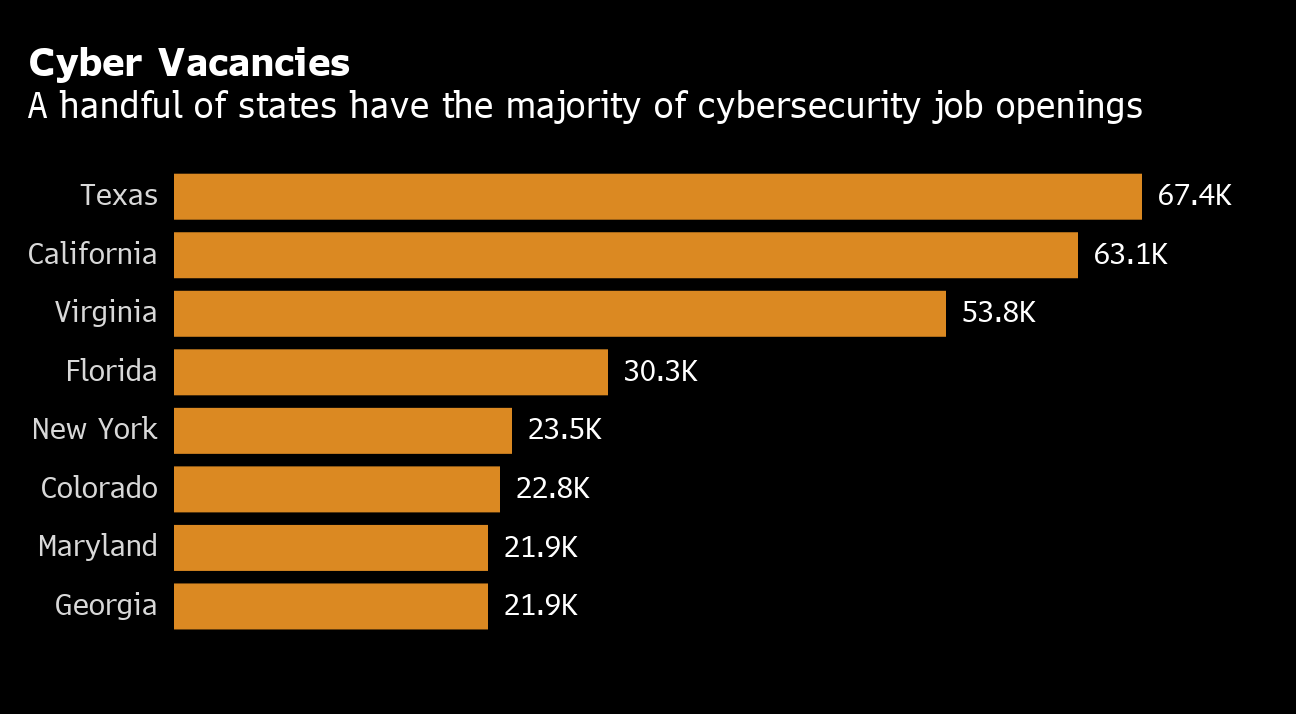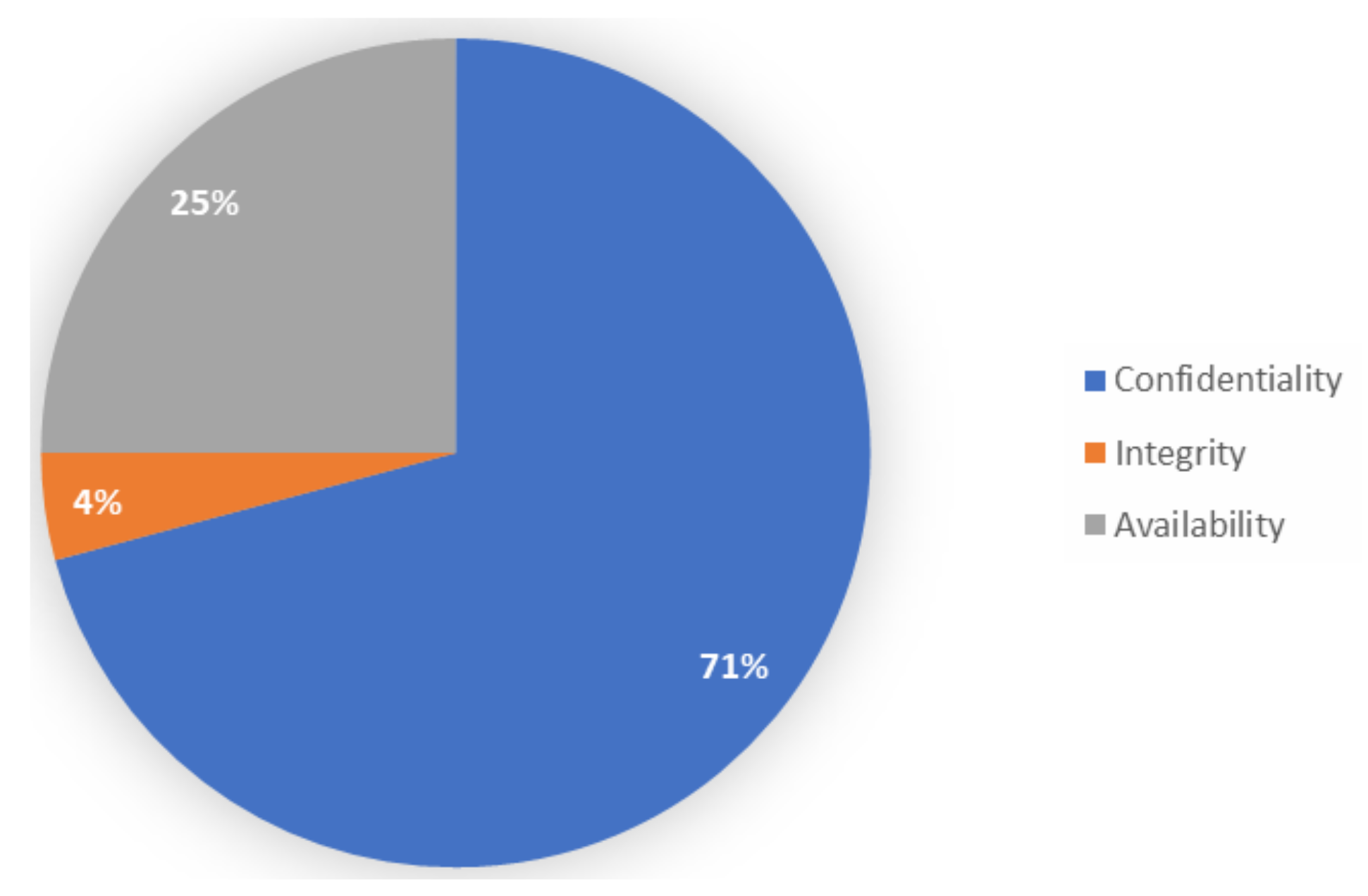Introduction
Welcome to the world of cybersecurity investment! As our lives become increasingly digitized, the need for robust cybersecurity measures is more critical than ever. Cyber threats and attacks are on the rise, targeting individuals, businesses, and even entire nations. To safeguard sensitive data, financial assets, and personal information, investing in cybersecurity has become a prudent choice.
Cybersecurity encompasses a range of technologies, processes, and practices designed to protect systems, networks, and data against unauthorized access, theft, or damage. This includes safeguarding against malware, ransomware, phishing attacks, data breaches, and other malicious activities. By investing in cybersecurity, you not only protect your own interests but contribute to the overall security and stability of the online ecosystem.
However, navigating the world of cybersecurity investment can be overwhelming, especially for those new to the field. With so many options and strategies available, it’s important to understand the different ways you can invest in cybersecurity and determine which approach aligns with your goals and risk tolerance.
In this guide, we will explore various avenues for investing in cybersecurity, including stocks, exchange-traded funds (ETFs), mutual funds, venture capital, startups, education, certifications, and infrastructure. Whether you’re a seasoned investor looking to diversify your portfolio or a novice seeking to enter the cybersecurity market, this guide will provide valuable insights and actionable strategies to help you make informed investment decisions.
It’s worth mentioning that investing in cybersecurity is not a surefire way to guarantee profits. Like any investment, there are risks involved, and market conditions can fluctuate. However, by staying informed, understanding the landscape, and engaging in thorough due diligence, you can position yourself for potential long-term growth in this ever-evolving field.
So, let’s dive into the world of cybersecurity investment and explore the exciting opportunities that lie ahead.
Why Cybersecurity is Important
In today’s digital age, where our lives are intertwined with technology, cybersecurity has become a paramount concern. The increasing reliance on digital platforms for communication, financial transactions, and storing sensitive information has made individuals, businesses, and governments vulnerable to cyber threats.
Here are a few key reasons why cybersecurity is of utmost importance:
1. Protecting Personal Information: Each one of us is connected to the internet in some way, and our personal information is stored online. Whether it’s our financial details, social media accounts, or medical records, this information is valuable to cybercriminals. By investing in cybersecurity, we safeguard our personal data from unauthorized access and prevent identity theft.
2. Safeguarding Business Assets: Businesses today rely heavily on technology to conduct operations, store data, and communicate with clients. A data breach or cyberattack can not only result in financial losses but also damage a company’s reputation and erode customer trust. Investing in cybersecurity measures helps businesses protect their intellectual property, customer data, and financial information.
3. Mitigating Financial Losses: Cyberattacks can have devastating financial consequences. From ransomware attacks that demand hefty payments to the costs involved in recovering from a breach, the financial impact can be immense. By investing in cybersecurity, businesses and individuals can mitigate the risks associated with financial losses due to cyber threats.
4. Maintaining National Security: Cybersecurity is a critical component of national security. Governments and critical infrastructure systems are highly vulnerable to cyberattacks, which can disrupt essential services, compromise sensitive information, and even threaten the safety of citizens. Investing in robust cybersecurity measures helps safeguard the integrity and stability of a nation.
5. Protecting Intellectual Property: For businesses, protecting intellectual property and proprietary information is crucial for maintaining a competitive edge. Investing in cybersecurity helps safeguard trade secrets, research and development data, and other valuable assets from being stolen or compromised.
6. Ensuring Privacy: Privacy is a fundamental right, and cybersecurity plays a vital role in preserving it. By investing in cybersecurity measures, individuals can ensure their online activities remain private and confidential, protecting them from surveillance, data mining, and unauthorized tracking.
In today’s interconnected world, where cyber threats continue to evolve and become more sophisticated, investing in cybersecurity is no longer a luxury but a necessity. It is vital for individuals, businesses, and nations to prioritize cybersecurity to protect themselves from the detrimental consequences of cybercriminal activities. By investing in robust cybersecurity measures and staying vigilant against emerging threats, we can create a safer and more secure digital landscape.
Assessing Your Risk
Before diving into cybersecurity investments, it’s essential to assess your risk and understand the potential vulnerabilities you may face. Evaluating your risk profile will help you determine the level of cybersecurity measures needed and the types of investments that align with your risk tolerance.
Here are some key steps to assess your risk:
1. Identify Your Assets: Start by identifying the assets that are most important to you or your business. This could include sensitive customer data, intellectual property, financial information, or critical infrastructure systems. By understanding what assets are at risk, you can prioritize your cybersecurity investments accordingly.
2. Analyze Potential Threats: Consider the potential threats that could affect your assets. This may include hackers, insider threats, malware, phishing attacks, or physical breaches. Understanding the specific risks you face will help you tailor your cybersecurity strategy to mitigate these threats effectively.
3. Evaluate Existing Security Measures: Assess the effectiveness of your current security measures. This includes evaluating your antivirus software, firewalls, encryption protocols, access controls, and employee training programs. Identify any gaps or weaknesses in your current security infrastructure that need to be addressed.
4. Consider Compliance Requirements: Depending on your industry, there may be specific regulatory compliance requirements related to cybersecurity. Evaluate whether your current systems and processes align with these requirements and determine any additional measures that need to be implemented to ensure compliance.
5. Measure Potential Impact: Assess the potential impact of a cybersecurity incident on your personal or business operations. Consider the financial, reputational, and operational consequences that could result from a breach or attack. This will help quantify the potential benefits of investing in cybersecurity measures.
6. Seek Professional Assistance: If assessing your risk feels overwhelming or you lack the expertise, consider seeking assistance from cybersecurity professionals. They can perform comprehensive risk assessments, identify vulnerabilities, and recommend appropriate mitigation strategies.
By carefully assessing your risk, you can make informed decisions about the cybersecurity investments that best align with your needs and risk profile. Keep in mind that cybersecurity is an ongoing process, and your risk profile may evolve over time. Regularly reevaluate your risk to adapt your cybersecurity strategy and make necessary adjustments to your investment portfolio. Remember, investing in cybersecurity is a proactive approach to safeguarding your assets and protecting against potential threats in an increasingly connected world.
Understanding Different Types of Cybersecurity Investments
When it comes to investing in cybersecurity, there are diverse avenues to explore. Understanding the different types of cybersecurity investments available will help you make informed decisions and diversify your portfolio to maximize potential returns. Here are some key categories of cybersecurity investments:
1. Cybersecurity Stocks: Investing in cybersecurity stocks involves purchasing shares of publicly traded companies that specialize in providing cybersecurity products and services. These companies may offer a wide range of solutions, including antivirus software, network security, encryption, and threat intelligence. By investing in cybersecurity stocks, you can directly participate in the growth of the industry and benefit from the success of leading cybersecurity companies.
2. Exchange-Traded Funds (ETFs): Cybersecurity ETFs offer a convenient way to invest in a diversified portfolio of cybersecurity stocks. These funds typically comprise shares of multiple cybersecurity companies, allowing you to gain exposure to the overall performance of the sector rather than investing in individual stocks. Investing in cybersecurity ETFs provides diversification and reduces the risk associated with investing in a single company.
3. Mutual Funds: Similar to ETFs, mutual funds pool money from multiple investors to invest in a diversified portfolio. Cybersecurity mutual funds specifically focus on investing in cybersecurity companies. These funds are managed by professional fund managers who research and select the stocks to include in the fund. Investing in cybersecurity mutual funds can provide broader exposure to the sector while benefiting from the expertise of fund managers.
4. Venture Capital: Investing in cybersecurity venture capital involves providing capital to startups and early-stage companies that are developing innovative cybersecurity technologies or solutions. Venture capital investments carry higher risk but also offer the potential for significant returns if the invested companies are successful. This type of investment allows you to be at the forefront of emerging cybersecurity trends and technologies.
5. Startups: Another option is to directly invest in cybersecurity startups. Investing in startups requires thorough due diligence and an understanding of the industry and market dynamics. By investing in promising cybersecurity startups, you have the opportunity to support innovative solutions and potentially benefit from their growth and success.
6. Education and Certifications: Investing in cybersecurity education and certifications is an indirect yet valuable investment in your knowledge and skills. By pursuing cybersecurity education programs and obtaining relevant certifications, you enhance your professional qualifications and increase your marketability in the cybersecurity industry. This investment can lead to better job opportunities and potential career advancement in the field.
7. Infrastructure: Investing in cybersecurity infrastructure involves acquiring and implementing robust security measures within your own personal or business systems. This could include investing in firewalls, intrusion detection systems, encryption protocols, and security monitoring tools. By proactively investing in cybersecurity infrastructure, you can fortify your defenses against potential threats and reduce the risk of successful attacks.
By diversifying your cybersecurity investments across these different categories, you can spread your risk and capitalize on the growth and advancements of the industry. Consider your risk tolerance, investment goals, and market conditions when deciding which types of cybersecurity investments align with your portfolio strategy. It’s important to conduct thorough research, seek professional advice if needed, and stay informed about industry trends and developments to make informed investment decisions in the ever-evolving cybersecurity landscape.
Investing in Cybersecurity Stocks
Investing in cybersecurity stocks is a popular choice for those looking to directly participate in the growth of the cybersecurity industry. By purchasing shares of publicly traded companies that specialize in cybersecurity products and services, investors have the opportunity to benefit from the success and advancements in this rapidly expanding sector.
Here are some key considerations when investing in cybersecurity stocks:
1. Research and Due Diligence: Before investing in any cybersecurity stock, it is essential to conduct thorough research and due diligence. Analyze the company’s financial health, growth prospects, competitive advantages, and recent performance in the market. Consider factors such as the company’s product portfolio, customer base, partnerships, and track record in addressing emerging cybersecurity threats.
2. Leading Players and Established Companies: Consider investing in established cybersecurity companies that have a strong presence in the market. Look for companies with a proven track record, solid financials, and a history of successful product launches and innovations. Leading players in the industry often have the resources and expertise to adapt to evolving threats and capitalize on the growing demand for cybersecurity solutions.
3. Consider Growth Potential: Evaluate the growth potential of the cybersecurity stocks you are considering. Look for companies that are well-positioned to take advantage of global cybersecurity trends, such as cloud security, artificial intelligence, and IoT security. Identifying companies with innovative technologies and a strong product pipeline can provide opportunities for long-term growth.
4. Industry Analysis: Stay informed about industry trends, news, and events that may impact the cybersecurity sector. Factors such as new regulations, major data breaches, or increasing cybersecurity spending by governments and businesses can influence the performance of cybersecurity stocks. Conducting regular industry analysis will help you make more informed investment decisions.
5. Diversify Your Portfolio: While investing in individual cybersecurity stocks can offer direct exposure to specific companies, it’s important to diversify your portfolio to spread the risk. Consider investing in a mix of cybersecurity stocks across different subsectors, such as network security, endpoint security, or cloud security. Diversification helps reduce the impact of any individual stock’s performance on your overall investment portfolio.
6. Monitor Performance and Stay Updated: Keep a close eye on the performance of the cybersecurity stocks in your portfolio. Monitor quarterly earnings reports, product announcements, market trends, and changes in the competitive landscape. It’s important to stay updated with the latest information and make adjustments to your portfolio if necessary.
Investing in cybersecurity stocks offers the potential for capital appreciation and dividend income, but it’s important to note that stock investments come with inherent risks. The cybersecurity industry is competitive and subject to market fluctuations, technological changes, and regulatory developments. It’s crucial to have a long-term investment mindset, conduct thorough research, stay informed, and seek professional advice if needed to make informed investment decisions in the dynamic world of cybersecurity stocks.
Investing in Cybersecurity ETFs
For investors looking to gain exposure to the cybersecurity sector without investing in individual stocks, cybersecurity exchange-traded funds (ETFs) offer a convenient and diversified investment option. Cybersecurity ETFs are designed to track the performance of a basket of cybersecurity companies, providing investors with a broader exposure to the sector.
Here are some key considerations when investing in cybersecurity ETFs:
1. Diversification: One of the primary advantages of investing in cybersecurity ETFs is the built-in diversification. ETFs typically hold a portfolio of stocks from various cybersecurity companies, spreading the risk across multiple holdings. This diversification helps reduce the impact of any individual stock’s performance on your investment, providing a more balanced exposure to the overall cybersecurity sector.
2. Expense Ratios: Consider the expense ratio of the cybersecurity ETF before investing. The expense ratio represents the annual cost of managing the ETF and is expressed as a percentage of the fund’s assets. Compare the expense ratios of different cybersecurity ETFs to ensure that you are selecting one with reasonable fees that align with your investment goals.
3. Index Methodology: Understand the underlying index methodology of the cybersecurity ETF you are considering. Each ETF tracks a specific index, which determines the selection and weighting of the constituent stocks. Some ETFs may use market capitalization weighting, while others may use factors like revenue or earnings to determine the weightings. Assess the index methodology to ensure it aligns with your investment preferences and objectives.
4. Liquidity: Consider the liquidity of the cybersecurity ETF. Look for ETFs that have sufficient average daily trading volume and a tight bid-ask spread. Higher liquidity ensures ease of buying and selling shares without significant price impact.
5. Performance and Historical Returns: Evaluate the historical performance of the cybersecurity ETF over different time periods. Compare the performance of the ETF with its benchmark index and other similar cybersecurity ETFs. While past performance is not indicative of future results, it can provide insights into the ETF’s ability to achieve its stated investment objective.
6. Size and Assets Under Management: Consider the size and assets under management (AUM) of the cybersecurity ETF. Larger ETFs generally have more liquidity and lower expense ratios. However, smaller ETFs may provide opportunities for potential growth if they offer exposure to niche segments or emerging cybersecurity trends.
7. Rebalancing and Portfolio Composition: Determine how frequently the cybersecurity ETF rebalances its portfolio. Rebalancing ensures that the ETF maintains its desired exposure to the cybersecurity sector. Additionally, review the portfolio composition to understand the allocation of the ETF across different subsectors or types of cybersecurity companies.
Investing in cybersecurity ETFs provides a convenient way to gain exposure to a diversified portfolio of cybersecurity stocks. However, it’s important to keep in mind that ETF investments carry the same market risks as individual stocks. Stay updated with the performance of the ETF, monitor changes in the cybersecurity sector, and regularly review your investment goals to ensure the cybersecurity ETF aligns with your investment strategy. As with any investment, conducting thorough research and seeking professional advice if needed can help you make informed decisions when investing in cybersecurity ETFs.
Investing in Cybersecurity Mutual Funds
For investors seeking exposure to the cybersecurity sector through a diversified portfolio, investing in cybersecurity mutual funds can be an attractive option. Cybersecurity mutual funds pool money from multiple investors and invest in a variety of cybersecurity-related companies, offering a convenient way to access the sector.
Here are some key considerations when investing in cybersecurity mutual funds:
1. Professional Management: One of the advantages of investing in mutual funds is having professional fund managers who research and select the cybersecurity stocks included in the fund. These fund managers have expertise in analyzing the cybersecurity industry, identifying potential investment opportunities, and managing the fund based on their investment strategy. Consider the track record and experience of the fund manager before investing in a cybersecurity mutual fund.
2. Diversification: Mutual funds provide diversification by investing in a range of cybersecurity stocks. By holding a diversified portfolio, mutual funds help spread the risk across multiple holdings. This diversification can help reduce the impact of any individual stock’s performance on your investment.
3. Expense Ratio: Evaluate the expense ratio of the cybersecurity mutual fund. The expense ratio represents the annual cost of managing the fund and is expressed as a percentage of the fund’s assets. Compare the expense ratios of different cybersecurity mutual funds to ensure that you are selecting one with reasonable fees that align with your investment goals.
4. Performance: Analyze the historical performance of the cybersecurity mutual fund over different time periods. Compare the fund’s performance with its benchmark index and other similar mutual funds in the cybersecurity sector. While past performance doesn’t guarantee future results, it can provide insights into the fund manager’s ability to deliver consistent returns.
5. Investment Strategy: Understand the investment strategy of the cybersecurity mutual fund. Some funds may focus on investing in large-cap companies, while others may focus on small-cap or growth-oriented cybersecurity stocks. Assess whether the fund’s investment strategy aligns with your risk tolerance and investment objectives.
6. Minimum Investment: Consider the minimum investment requirement for the cybersecurity mutual fund. Each fund may have its own minimum investment threshold, which represents the minimum amount of money required to invest in the fund. Ensure that the minimum investment aligns with your investment capabilities.
7. Turnover Ratio: Examine the turnover ratio of the cybersecurity mutual fund. The turnover ratio measures the frequency with which the fund buys and sells securities within its portfolio. Higher turnover ratios may result in higher transaction costs and potential tax implications. Assess the fund’s turnover ratio to understand the potential impact on your investment returns.
Investing in cybersecurity mutual funds can offer a balanced and professionally managed approach to gaining exposure to the sector. However, like any investment, it’s important to conduct thorough research, review the fund’s prospectus, and consider your risk tolerance and investment objectives before investing. By evaluating the performance, expenses, and investment strategy of cybersecurity mutual funds, you can make informed investment decisions and potentially benefit from the growth and opportunities in the cybersecurity industry.
Investing in Cybersecurity Venture Capital
Investing in cybersecurity venture capital provides a unique opportunity to support and invest in early-stage companies that are developing innovative cybersecurity technologies and solutions. Venture capital investments carry higher risk, but they also offer the potential for significant returns if the invested companies are successful in the market.
Here are some key considerations when investing in cybersecurity venture capital:
1. Risk and Return: Investing in cybersecurity venture capital involves higher risk compared to more established investments. Startups are inherently risky, and a significant percentage of them fail. However, successful investments in cybersecurity startups can lead to substantial returns, as innovative technology and strong cybersecurity solutions are in high demand.
2. Due Diligence: Thorough due diligence is crucial when investing in cybersecurity venture capital. Evaluate the startup’s business model, management team, industry experience, intellectual property, competitive landscape, and growth potential. Assess the startup’s ability to address cybersecurity challenges effectively and its potential to disrupt the market with unique and scalable solutions.
3. Investment Structure: Understand the investment structure when investing in cybersecurity venture capital. Venture capital investments are typically made through limited partnerships or venture capital funds. These funds pool money from multiple investors and invest in a portfolio of startups. Consider the investment terms, including the investment period, potential follow-on investment opportunities, and expected exit strategies.
4. Expertise and Network: Venture capital firms often provide more than just capital. They offer valuable expertise, guidance, and industry connections to the startups they invest in. Consider partnering with venture capital firms with a track record in the cybersecurity industry and a strong network of advisors and strategic partners. Their expertise and network can contribute to the success of the invested startups.
5. Portfolio Diversification: Investing in multiple cybersecurity startups can help mitigate risk and increase the potential for returns. Diversify your venture capital investments across different startups, technology subsectors, and stages of development. A well-diversified portfolio balances the risk associated with individual investments and maximizes the potential for successful exits.
6. Long-Term Horizon: Investing in cybersecurity venture capital requires a long-term mindset. Startup investments often take time to mature, and it may be several years before an exit opportunity arises. Maintain a long-term perspective and be prepared to provide ongoing support and resources to the invested startups to increase their chances of success.
7. Exit Strategies: Understand the potential exit strategies for your venture capital investments. Common exit strategies include mergers and acquisitions, initial public offerings (IPOs), or secondary offerings. Evaluate the startup’s potential for an exit and the likelihood of generating substantial returns upon exit.
Investing in cybersecurity venture capital can be exciting and rewarding, given the potential for significant returns and the opportunity to support innovative cybersecurity startups. However, it’s important to carefully evaluate investment opportunities, conduct thorough due diligence, and have a diversified portfolio to manage risk. Partnering with experienced venture capital firms and staying updated on industry trends can enhance your chances of making successful investments in the cybersecurity startup ecosystem.
Investing in Cybersecurity Startups
Investing in cybersecurity startups offers the opportunity to be part of emerging technologies and support innovative solutions that address the growing cybersecurity challenges. While investing in startups carries higher risk, it also presents the potential for significant returns if the companies succeed and achieve scalability in the market.
Here are some important considerations when investing in cybersecurity startups:
1. Evaluate the Business Idea: Thoroughly assess the startup’s business idea and the problem it aims to solve. Consider the uniqueness and scalability of the solution, market demand, competitive landscape, and potential for long-term growth. Look for startups that have disruptive technologies or innovative approaches to cybersecurity.
2. Management Team: The management team plays a vital role in the success of a startup. Evaluate the experience and expertise of the founders and key executives. Look for teams that have a strong background in cybersecurity and a track record of successful ventures. A capable and experienced management team increases the probability of executing the business plan effectively.
3. Market Size and Growth Potential: Assess the market size and growth potential of the cybersecurity startup’s target market. Look for startups that operate in large and expanding markets, as this provides greater opportunities for growth. Consider factors such as the market’s projected growth rate, competition, and the startup’s competitive advantages.
4. Financial Viability: Evaluate the financial viability and sustainability of the cybersecurity startup. Review the startup’s financial projections, revenue model, and funding needs. Assess if the startup has secured sufficient funding to execute its business plan and reach key milestones. It’s important to determine if the startup’s financial goals align with your investment expectations.
5. Due Diligence: Conduct thorough due diligence before investing in a cybersecurity startup. Analyze the startup’s technology, intellectual property assets, existing customer base, partnerships, and growth trajectory. Engage in discussions with the startup’s management team to gain deeper insights into their business and address any concerns or questions you may have.
6. Portfolio Diversification: To mitigate the risk associated with startup investments, consider building a diversified portfolio. Spread your investments across multiple cybersecurity startups to minimize the potential impact of any individual startup’s performance. Diversification allows you to benefit from the growth potential of various companies while managing risk.
7. Exit Strategy: Understand the startup’s potential exit strategy. Common exit strategies for cybersecurity startups include acquisitions by larger cybersecurity companies or initial public offerings (IPOs). Evaluate the startup’s potential for an exit and the likelihood of generating substantial returns through exit events.
Investing in cybersecurity startups requires a thorough understanding of the market, careful evaluation of investment opportunities, and a long-term perspective. It’s advisable to seek professional advice and engage with networks or platforms that connect investors with startups. By partnering with promising cybersecurity startups and providing support beyond capital, you contribute to the growth of innovative solutions and position yourself for potential returns in the ever-evolving cybersecurity landscape.
Investing in Cybersecurity Education and Certifications
Investing in cybersecurity education and certifications is an indirect yet highly valuable investment in your knowledge, skills, and professional development. In an industry that is constantly evolving, staying updated with the latest cybersecurity practices and obtaining relevant certifications can provide a competitive edge and open doors to new career opportunities.
Here are some key considerations when investing in cybersecurity education and certifications:
1. Identify Your Objectives: Clarify your objectives and reasons for investing in cybersecurity education and certifications. Determine whether you aim to enhance your current skills, switch careers, or establish yourself in the cybersecurity industry. Defining your goals will help identify the best educational programs and certifications to pursue.
2. Evaluate Program Credibility: When enrolling in cybersecurity education programs, consider their credibility and reputation. Look for programs that are recognized by industry-leading organizations or accredited institutions. Research program reviews and alumni experiences to gauge the quality and relevance of the education provided.
3. Relevance and Currency: The cybersecurity landscape evolves rapidly, so it’s crucial to invest in education and certifications that are relevant and up to date. Ensure that the curriculum covers the latest cybersecurity practices, emerging threats, and technological advancements. Verify that the certifications are recognized within the industry for their rigor and validity.
4. Cost-Benefit Analysis: Consider the cost of the educational program or certification and weigh it against the potential benefits it can provide. Assess the return on investment (ROI) in terms of career advancement, salary potential, and marketability. While investing in education and certifications may incur expenses, the long-term benefits can outweigh the initial costs.
5. Networking Opportunities: Look for educational programs and certifications that offer networking opportunities with industry professionals. Building connections within the cybersecurity community can provide access to valuable insights, job opportunities, and collaborations. Engage with fellow learners, instructors, and alumni to grow your professional network.
6. Continuing Education: Recognize that cybersecurity is a field that requires lifelong learning. Invest in ongoing professional development to stay updated with the latest industry trends and advancements. Look for certification programs that offer continuing education opportunities or consider attending industry conferences and workshops.
7. Career Advancement: Investing in cybersecurity education and certifications can help advance your career within the field. Employers often value candidates who possess relevant certifications and demonstrate a commitment to continuous learning. Investing in your education can open doors to higher-level positions, increased responsibilities, and enhanced earning potential.
By investing in cybersecurity education and certifications, you enhance your knowledge, skills, and professional credibility in a field that continues to grow in importance. Choose programs and certifications that align with your goals, prioritize relevance and currency, and consider the long-term career benefits. With continuous learning and professional development, you position yourself as a valuable asset in the ever-evolving realm of cybersecurity.
Investing in Cybersecurity Infrastructure
Investing in cybersecurity infrastructure involves acquiring and implementing robust security measures within your personal or business systems. By fortifying your defenses and safeguarding against potential threats, you can significantly reduce the risk of successful cyber attacks and protect sensitive data. Investing in cybersecurity infrastructure is essential in today’s digital landscape, where cyber threats continue to evolve.
Here are some key considerations when investing in cybersecurity infrastructure:
1. Assess Your Current Setup: Begin by assessing your existing cybersecurity infrastructure. Identify any vulnerabilities or weaknesses that may exist in your systems, networks, or processes. Evaluate your current security protocols, encryption methods, access controls, firewalls, and security software. This assessment will help pinpoint areas where investments in cybersecurity infrastructure are needed.
2. Implement Multi-Layered Security: Cybersecurity infrastructure should include multiple layers of protection to create a robust defense against potential threats. Implement a combination of hardware and software solutions such as firewalls, intrusion detection systems, antivirus software, and data loss prevention tools. Each layer adds an additional barrier to potential attacks, increasing the overall security of your systems.
3. Stay Current with Updates: Regularly update and patch your software, operating systems, and security applications. New vulnerabilities and weaknesses are discovered regularly, and software updates often contain security fixes to address these issues. Staying current with updates ensures that you have the latest security patches to protect against emerging threats.
4. Employee Training and Awareness: Investing in cybersecurity infrastructure also involves investing in employee training and awareness programs. Educate your employees about best practices for cybersecurity, including strong password management, identifying phishing attempts, and avoiding suspicious emails or links. Promote a culture of security and ensure that your team understands their role in maintaining strong cybersecurity measures.
5. Backup Systems and Disaster Recovery: Invest in robust backup systems and disaster recovery plans. Regularly back up your critical data and ensure that backup systems are secure and accessible in case of an attack or other catastrophic event. A strong backup and disaster recovery strategy will help mitigate the impact of potential data breaches or system failures.
6. Engage with Security Professionals: Consider partnering with cybersecurity experts or managed security service providers (MSSPs) to enhance your cybersecurity infrastructure. These professionals have the knowledge and experience to assess your systems, identify vulnerabilities, and provide guidance on implementing effective security measures.
7. Stay Educated about Emerging Threats: Regularly educate yourself about emerging cyber threats and evolving security technologies. The cyber threat landscape is constantly changing, and it’s important to stay informed about new attack vectors and defense strategies. Subscribe to cybersecurity newsletters, participate in industry forums, and attend relevant conferences or webinars to stay updated.
Investing in cybersecurity infrastructure is crucial for protecting your personal or business data and maintaining a secure digital environment. Assess your current setup, implement a multi-layered security approach, and prioritize employee training and awareness. Remember to stay current with updates, backup critical data, engage with cybersecurity experts, and stay informed about emerging threats. By investing in robust cybersecurity infrastructure, you take proactive steps to protect against potential cyber attacks and safeguard your digital assets.
Conclusion
Investing in cybersecurity is a wise choice in today’s increasingly digital world, where cyber threats are on the rise. By understanding the different types of cybersecurity investments available, you can make informed decisions that align with your goals and risk tolerance. Whether you choose to invest in cybersecurity stocks, ETFs, mutual funds, venture capital, startups, education and certifications, or infrastructure, each avenue presents unique opportunities to participate in the growth and protection of the cybersecurity sector.
When investing in cybersecurity, it is important to conduct thorough research, evaluate the performance and credibility of the investments, and stay updated with industry trends. Consider diversifying your portfolio to manage risk effectively and take a long-term perspective. Recognize that investing in cybersecurity comes with inherent risks, and it’s essential to stay informed and adapt your investment strategy accordingly.
Additionally, investing in cybersecurity goes beyond financial investments. It also encompasses investing in education and certifications to enhance your knowledge and professional skills, as well as investing in robust cybersecurity infrastructure to protect your personal or business systems.
Remember, cybersecurity is an evolving field, and staying ahead requires continuous learning and adaptation. Stay informed about emerging threats, industry developments, and regulatory changes to make informed investment decisions and protect yourself or your businesses from potential cyber risks.
As you navigate the world of cybersecurity investment, always prioritize security, diligence, and ongoing education. By doing so, you can contribute to a safer digital environment and potentially reap the rewards of investing in a sector that plays a crucial role in protecting our increasingly interconnected world.







